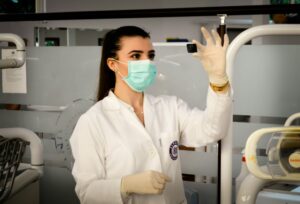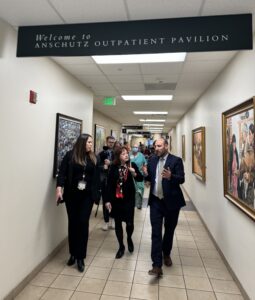Navigating the unknown: Colorado’s data-driven approach to tackling Long COVID challenges
For Katherine Hochevar, life looked vastly different at the end of COVID-19 pandemic than it had at the beginning. In the span of two years, she found out she was pregnant, gave birth to her son, and changed her career from K-12 education to join the data management team at the State of Colorado’s Office of Information Technology, all amidst an unprecedented global health crisis.
Then, a “new normal” began to emerge as the world set out on shaky legs to regain its bearings and begin its self-proclaimed recovery. Hochevar, and countless others, came back to offices left vacant for more than a year.
“Except, not everyone came back,” she said. “There was some loss of life, but there were also people who just couldn’t come back–people you no longer saw in meetings or spoke to at lunch. That was one of the first times it became very close to home.”
In early 2021, the concept of Long COVID was not widely recognized, or at least a name had not yet been put to it. Today, the term represents a condition with many subsets and more than 200 potential symptoms that can affect nearly every part of the body—from extreme fatigue and brain fog to tachycardia, joint pain, headaches and everything in between. While much is still unknown about Long COVID, and the condition itself is largely self-reported, research has found that 14 percent of Americans say they have suffered from it at some point. Additionally, due to the unpredictable and often debilitating nature of the condition, more than half of these individuals become part-time employees or are out of work entirely after infection.

Colorado is one of the only states in the nation to tackle the issue of Long COVID head-on. In Colorado’s Next Chapter: Our Roadmap to Moving Forward, released in February 2022, the Polis-Primavera administration had the foresight to call for investment and research into the disease. Colorado House Bill 22-1401 authorized the Office of Saving People Money on Health Care to undertake this work.
Estimates in the state show that there may be as many as 651,000 individuals who developed Long COVID by December 2022. Based on the current labor force participation rate in the state, experts say between 173,000 and 304,000 working-age (18 to 65) Coloradans are experiencing Long COVID and between 140,000 and 250,000 people with Long COVID have been participating in the workforce, with more than a quarter of them likely experiencing significant activity limitations due to their illness.
“But estimates cannot paint a full picture, and they cannot get Coloradans the help they need to be able to fully reclaim their lives, participate in their communities, and contribute to the economy,” Hochevar said.
“The true extent of the problem just isn’t known,” she said. “And how can we monitor what we don’t know? How will we know if the problem is growing, shrinking, staying the same? How much energy should we put toward mitigating some of the impacts of Long COVID? We need better information.”

Throughout their pandemic response, Colorado prioritized data-driven decisionmaking data transparency. That’s why in March 2023, Hochevar and a cross-functional state team led by the Office of Saving People Money on Health Care and Colorado’s senior policy advisor on Long COVID, Dr. Mirwais Baheej, joined Data Labs—an eight-month program designed by the Beeck Center for Social Impact + Innovation and the National Governors Association to offer hands-on support in the execution of thoughtfully-designed data projects intended to improve workforce transitions, safety net benefits, and student outcomes. Colorado was one of six states—including Arizona, Connecticut, West Virginia, Minnesota, and Nevada—to join the second cohort of the program, which pairs a human-centered design curriculum with individualized support to give state teams a framework to think through data challenges and solutions, as well as customized guidance that meets them where they are at.
The Colorado team entered Data Labs with the goal of building a framework to plan for Long COVID’s impact on the state. To understand the disease’s effect on workforce transitions, the team aimed to identify its data needs, develop a comprehensive data system to inform policy, and work to improve access to career opportunities for those impacted by Long COVID.
“People with Long COVID face a period of uncertainty while they wait for confirmation from their health care provider on a diagnosis. There isn’t a simple test you can take,” said Dr. Baheej. “And because so many employers’ organizational policies are diagnosis-led when it comes to benefits and leave, while people wait for their diagnosis they can’t return to work, they can’t manage their time, they can’t plan for the future.”
Dr. Baheej knows firsthand the complexities of navigating a Long COVID diagnosis, and the role that diagnosis can play in a person’s life. In early 2022, his brother-in-law, having had COVID a few months prior, began experiencing a host of health problems, which his doctors attributed to congestive heart failure. For a construction worker who owned his own business, the news was devastating.
It was a cardiologist who eventually suggested that the original diagnosis may be incorrect, and introduced both Dr. Baheej and his brother-in-law to the concept of Long COVID.
“Even as a medical doctor, myself, Long COVID was not something I had heard of or really understood yet; we all initially thought Long COVID had to do with your mental health, and not your physical health,” Dr. Baheej said.
A characteristic of Long COVID that differentiates it from many other serious, long term illnesses—and which Dr. Baheej saw in the case of his brother-in-law—is that recovery is possible. With the right support and accommodations from employers, people can also continue working and, in turn, keep their benefits.
But, in order to provide that support, employers need guidance and policies to adhere to from the State or the federal government, but the State cannot provide direction without an understanding of the scope of the problem. As the Data Labs team dug in, they quickly realized what was needed was a strategic approach to large scale data-sharing efforts at the state level.
“In a lot of ways, this project has been like a needs analysis of finding where our gaps are. Where are the siloes? Where do we need to be doing something different entirely?” Hochevar said. “We’re going to have to establish some better pathways when we do need to share data and I don’t know that I would have even been involved in this process or even aware of the need for this work had it not been for Data Labs.”
Beyond the technical framework the team is building to improve the State’s data-sharing capacity, the team also realized the need to build out a framework for engaging with the less concrete aspects of the project: the people. After hitting roadblocks in their attempts to bring various agencies together, the team, with the support of Data Labs Program Manager Vinith Annam, saw that the people were also siloed.
“We needed to make people see themselves and their agencies in this process. So why call it a project? It’s so much more than that,” Dr. Baheej said. “It is something that is affecting all of our systems—health, workforce, education, the socio-economic fabric of society and the wellbeing of Coloradans. So we needed to shift from a project mindset to a collaborative one. If we get there, then we’ll be addressing things in a whole-of-government and a whole-of-society way.”
To that end, the Colorado team used their time in Data Labs to make significant headway in defining a data surveillance strategy and estimating the burden of Long COVID on the workforce to inform policy. The team has also established communication processes with the state agencies and other stakeholders to better understand the needs and challenges inherent in sharing data, convened leaders of existing data collaboratives to share best practices, and enhanced their existing short term data sharing mechanisms.
Equally as important, though, is the groundwork the team has laid for how the State responds to the next crisis.
“What if it’s another pandemic, or climate change?” Hochevar said. “Data Labs has taught us how to position people to come to the table to talk about a novel problem, how to get the right technology to support the investigation of this problem, and how to bring people together at the right time. Those skills are invaluable no matter the crisis.”
Interested in joining the next cohort of Data Labs? We are now accepting proposals for our third cohort. Click here to learn more and apply, or contact datalabs@georgetown.edu.